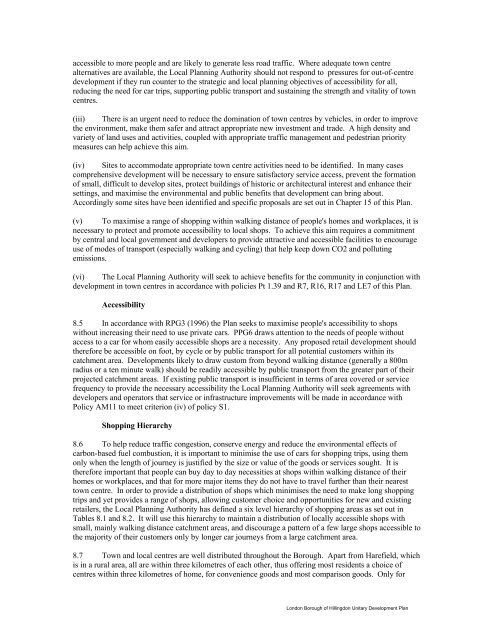HILLINGDON UNITARY DEVELOPMENT PLAN - London Borough ...
HILLINGDON UNITARY DEVELOPMENT PLAN - London Borough ...
HILLINGDON UNITARY DEVELOPMENT PLAN - London Borough ...
Create successful ePaper yourself
Turn your PDF publications into a flip-book with our unique Google optimized e-Paper software.
accessible to more people and are likely to generate less road traffic. Where adequate town centre<br />
alternatives are available, the Local Planning Authority should not respond to pressures for out-of-centre<br />
development if they run counter to the strategic and local planning objectives of accessibility for all,<br />
reducing the need for car trips, supporting public transport and sustaining the strength and vitality of town<br />
centres.<br />
(iii) There is an urgent need to reduce the domination of town centres by vehicles, in order to improve<br />
the environment, make them safer and attract appropriate new investment and trade. A high density and<br />
variety of land uses and activities, coupled with appropriate traffic management and pedestrian priority<br />
measures can help achieve this aim.<br />
(iv) Sites to accommodate appropriate town centre activities need to be identified. In many cases<br />
comprehensive development will be necessary to ensure satisfactory service access, prevent the formation<br />
of small, difficult to develop sites, protect buildings of historic or architectural interest and enhance their<br />
settings, and maximise the environmental and public benefits that development can bring about.<br />
Accordingly some sites have been identified and specific proposals are set out in Chapter 15 of this Plan.<br />
(v) To maximise a range of shopping within walking distance of people's homes and workplaces, it is<br />
necessary to protect and promote accessibility to local shops. To achieve this aim requires a commitment<br />
by central and local government and developers to provide attractive and accessible facilities to encourage<br />
use of modes of transport (especially walking and cycling) that help keep down CO2 and polluting<br />
emissions.<br />
(vi) The Local Planning Authority will seek to achieve benefits for the community in conjunction with<br />
development in town centres in accordance with policies Pt 1.39 and R7, R16, R17 and LE7 of this Plan.<br />
Accessibility<br />
8.5 In accordance with RPG3 (1996) the Plan seeks to maximise people's accessibility to shops<br />
without increasing their need to use private cars. PPG6 draws attention to the needs of people without<br />
access to a car for whom easily accessible shops are a necessity. Any proposed retail development should<br />
therefore be accessible on foot, by cycle or by public transport for all potential customers within its<br />
catchment area. Developments likely to draw custom from beyond walking distance (generally a 800m<br />
radius or a ten minute walk) should be readily accessible by public transport from the greater part of their<br />
projected catchment areas. If existing public transport is insufficient in terms of area covered or service<br />
frequency to provide the necessary accessibility the Local Planning Authority will seek agreements with<br />
developers and operators that service or infrastructure improvements will be made in accordance with<br />
Policy AM11 to meet criterion (iv) of policy S1.<br />
Shopping Hierarchy<br />
8.6 To help reduce traffic congestion, conserve energy and reduce the environmental effects of<br />
carbon-based fuel combustion, it is important to minimise the use of cars for shopping trips, using them<br />
only when the length of journey is justified by the size or value of the goods or services sought. It is<br />
therefore important that people can buy day to day necessities at shops within walking distance of their<br />
homes or workplaces, and that for more major items they do not have to travel further than their nearest<br />
town centre. In order to provide a distribution of shops which minimises the need to make long shopping<br />
trips and yet provides a range of shops, allowing customer choice and opportunities for new and existing<br />
retailers, the Local Planning Authority has defined a six level hierarchy of shopping areas as set out in<br />
Tables 8.1 and 8.2. It will use this hierarchy to maintain a distribution of locally accessible shops with<br />
small, mainly walking distance catchment areas, and discourage a pattern of a few large shops accessible to<br />
the majority of their customers only by longer car journeys from a large catchment area.<br />
8.7 Town and local centres are well distributed throughout the <strong>Borough</strong>. Apart from Harefield, which<br />
is in a rural area, all are within three kilometres of each other, thus offering most residents a choice of<br />
centres within three kilometres of home, for convenience goods and most comparison goods. Only for<br />
<strong>London</strong> <strong>Borough</strong> of Hillingdon Unitary Development Plan
















